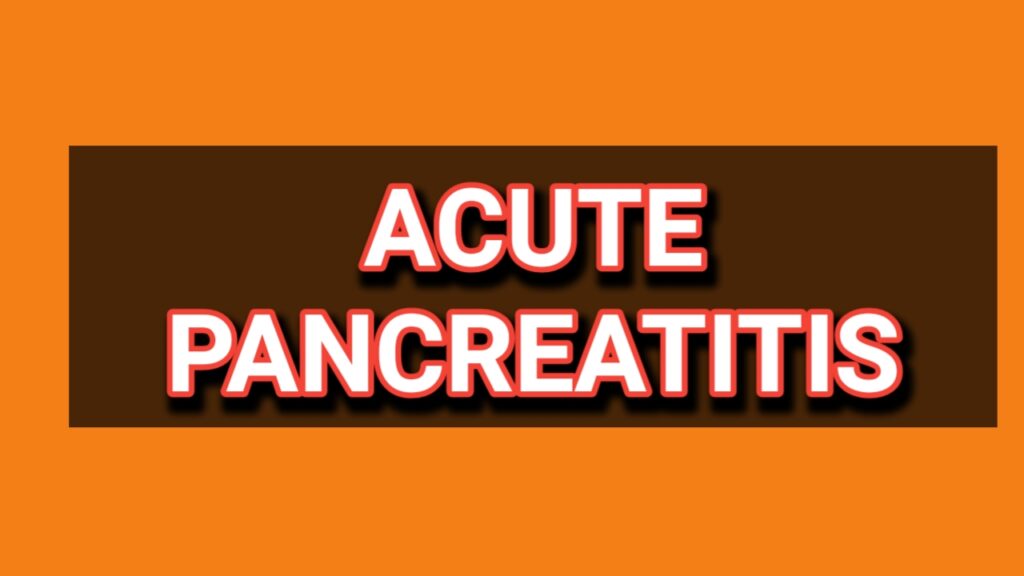Pancreas is small sized gland situated in back of abdomen,behind the stomach.Size of pancreas is about 6 inch long(3.0 cm-head, 2.5 cm for neck and body of pancreas, and 2.0 cm for the tail of pancreas).Infection of pancreas normaly known as pancreatitis.Here we are discussing about acute pancreatitis-causes,clinical features,diagnosis and management…
also read chronic pancreatitis
Causes of acute pancreatitis
• Gallstones causes acute pancreatitis
• Alcoholism is another cause of acute pancreatitis
• Hyperlipidaemia-excess lipid in blood&Hypercalcaemia-excessive calcium accumulation (hyperparathyroidism, multiple myeloma).
• Damage or accident from trauma, ERCP, post-surgery, cardiopulmonary bypass
• Toxins:continual usage of Drugs,
• NSAIDs.
•Viral or bacterial Infections like mumps, Cyto Megalo Virus infection, hepatitis B,mycoplasma.
• Venom from scorpion&snake bites).
• Idiopathic.
Classification
There are 3 types
• Oedematous-Most common type.May be simple or associated with phlegmon formation; transient fluid collections is seen
• Severe/necrotizing-one fourth of acute pancreatitis is due to Necrosis may be sterile or infected.
• Haemorrhagic-Less common
Clinical features of acute pancreatitis
•fever
• Severe Abdominal pain especially in epigastric region radiating to the back.
• Nausea and vomiting.
• dehydration, hypotension, tachycardia.
• Epigastric tenderness associated with guarding and in severe cases, rigidity which may be generalized.
• Grey–Turner’s sign &Cullen’s sign is seen in some cases
diagnosis of acute pancreatitis
• Serum amylase >1000U. is Diagnostic criteria, but may be normal even in severe cases; elevated amylase may occur in a wide range of other acute abdominal conditions like intestinal ischaemia, leaking aneurysm, perforated ulcer, cholecystitis.
• Serum lipase. Remains elevated longer than serum amylase; more specifi c, but less sensitive
Leukocytosis With more severe & Hemoconcentration with PCV >44% from loss of plasma into the
retroperitoneal space and peritoneal ‘o prerenalazotemia cavity Hemoconcentration may be the harbinger of more severe disease (i.e., pancreatic necrosis), Whereas azotemia is a significant risk factor for mortality Hyperglycemia is common and multifactorial I insulin, Tglucagon, 1 adrenal glucocorticoids & catecholamines
Hypocalcemia occurs in -25% o pathogenesis incompletely understood
Intraperitoneal saponification of Catby fatty acids in areas of fat necrosis occurs occasionally, with large amounts (up to 6.0 g) dissolved or suspended in ascitic fluidSo Hyperbilirubinemia in -10%of patientsHowever, jaundice is transient Alk. Phos. & AST also transiently elevated, o parallel serum bilirubin values and may point to GB-related disease on inflammation in the pancreatic head Hypertriglyceridemia in 5-10%of patients,
serum amylase levels in these individuals are often spuriously normal 595-10% of patients have hypoxemia
ECG abnormalities-occasional ST-segment and T-wave abnormalities simulating myocardial ischemia
Abdominal tal Recommended as the initial diagnostic imaging modality
Useful to evaluate for gallstone disease and the pancreatic head The revised Atlanta criteria have clearly outlined the morphologic features of acute pancreatitis on computed tomography
Contrast Enhanced CT(CECT) abdomen Imaging modality of choice
• Wider availability, Faster examination time-good images in critically ill, Relatively cheaper MRI for multiple follow-up examinations to reduce exposure to radiation o when CECT is contraindicated
when characterisation of specific lesions, mainly fluid collections, is warrantedso
Revised Atlanta criteria have clearly outlined the morphologic features of acute pancreatitis on CT ‘o (1) interstitial pancreatitis ‘o (2) necrotizing pancreatitis
(3) acute pancreatic fluid collection o (4) pancreatic pseudocyst o (5) acute necrotic collection (ANC) o (6) walled-off pancreatic necrosis (WON)
• AXR (non-specifi c fi ndings). Absent psoas shadows, ‘sentinel loop sign’ (dilated proximal jejunal loop adjacent to pancreas because of local ileus’), ‘colon cut-off sign’ (distended colon to mid-transverse colon with no air distally); may show gallstone, pancreatic calcifi cation.
• CT -Through this we can see pancreatic oedema, pancreatic swelling, haemorrhagic or necrotic complications.
• USG. Take as early as possible to rule out gallstones in the bile duct
Differential Diagnosis (DD of acute abdomen)
- (1) perforated viscus, especially peptic ulcer
- (2) acute cholecystitis and biliary colic;
- (3) acute intestinal obstruction
- (4) mesenteric vascular occlusion
- (5) renal colic
- (6) inferior myocardial infarction
- (7) dissecting aortic aneurysm
- (8) connective tissue disorders with vasculitis
- (9) pneumonia
- (10) diabetic ketoacidosis
Is loose motion symptom of pancreatitis?
In most cases of pancreatitis, fever,abdominal pain,vomiting…are most common symptom.Less commonly loose motion is seen

